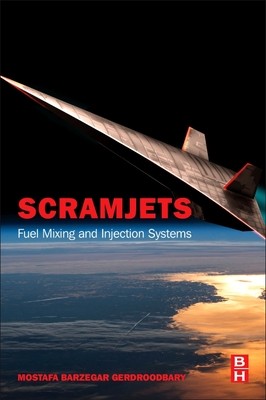
- We will send in 10–14 business days.
- Author: Mostafa Barzegar Gerdroodbary
- Publisher: Butterworth-Heinemann
- ISBN-10: 0128211385
- ISBN-13: 9780128211380
- Format: 15.2 x 22.9 x 1.2 cm, softcover
- Language: English
- SAVE -10% with code: EXTRA
Reviews
Description
Scramjet engines are a type of jet engine and rely on the combustion of fuel and an oxidizer to produce thrust. While scramjets are conceptually simple, actual implementation is limited by extreme technical challenges. Hypersonic flight within the atmosphere generates immense drag, and temperatures found on the aircraft and within the engine can be much greater than that of the surrounding air. Maintaining combustion in the supersonic flow presents additional challenges, as the fuel must be injected, mixed, ignited, and burned within milliseconds. Fuel mixing, along with the configuration and positioning of the injectors and the boundary conditions, play a key role in combustion efficiency.
Scramjets: Fuel Mixing and Injection Systems discusses how fuel mixing efficiency and the advantage of injection systems can enhance the performance of the scramjets. The book begins with the introduction of the supersonic combustion chamber and explains the main parameters on the mixing rate. The configuration of scramjets is then introduced with special emphasis on the main effective parameters on the mixing of fuel inside the scramjets. In addition, basic concepts and principles on the mixing rate and fuel distribution within scramjets are presented. Main effective parameters such as range of fuel concentration for the efficient combustion, pressure of fuel jet and various arrangement of jet injections are also explained. This book is for aeronautical and mechanical engineers as well as those working in supersonic combustion who need to know the effects of compressibility on combustion, of shocks on mixing and on chemical reactions, and vorticity on the flame anchoring.
EXTRA 10 % discount with code: EXTRA
The promotion ends in 19d.20:44:07
The discount code is valid when purchasing from 10 €. Discounts do not stack.
- Author: Mostafa Barzegar Gerdroodbary
- Publisher: Butterworth-Heinemann
- ISBN-10: 0128211385
- ISBN-13: 9780128211380
- Format: 15.2 x 22.9 x 1.2 cm, softcover
- Language: English English
Scramjet engines are a type of jet engine and rely on the combustion of fuel and an oxidizer to produce thrust. While scramjets are conceptually simple, actual implementation is limited by extreme technical challenges. Hypersonic flight within the atmosphere generates immense drag, and temperatures found on the aircraft and within the engine can be much greater than that of the surrounding air. Maintaining combustion in the supersonic flow presents additional challenges, as the fuel must be injected, mixed, ignited, and burned within milliseconds. Fuel mixing, along with the configuration and positioning of the injectors and the boundary conditions, play a key role in combustion efficiency.
Scramjets: Fuel Mixing and Injection Systems discusses how fuel mixing efficiency and the advantage of injection systems can enhance the performance of the scramjets. The book begins with the introduction of the supersonic combustion chamber and explains the main parameters on the mixing rate. The configuration of scramjets is then introduced with special emphasis on the main effective parameters on the mixing of fuel inside the scramjets. In addition, basic concepts and principles on the mixing rate and fuel distribution within scramjets are presented. Main effective parameters such as range of fuel concentration for the efficient combustion, pressure of fuel jet and various arrangement of jet injections are also explained. This book is for aeronautical and mechanical engineers as well as those working in supersonic combustion who need to know the effects of compressibility on combustion, of shocks on mixing and on chemical reactions, and vorticity on the flame anchoring.


Reviews